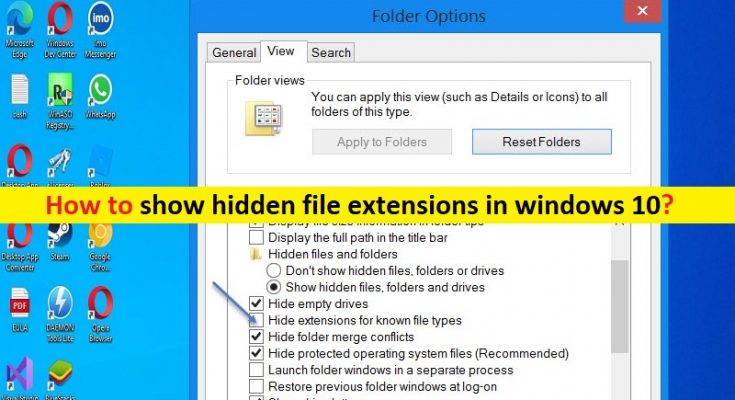Tips to Show file extensions, show hidden file extensions in windows 10:
In this article, we are going to discuss on How to Show file extensions in windows 10, How to show hidden file extensions in windows 10. You will be guided with easy steps/methods to do so. Let’s starts the discussion.
‘Show file extensions, show hidden file extensions in windows 10’:
‘File Extension’: File Extension helps you to identify the file type. For example, .exe file extension indicates it is excitable file/program. If you are regular Windows 10/11 user, then it is not at all big issue to identify the file type. Identifying file extension of the file you are trying to open is one of the best ways to secure your PC from any attack if possible.
Since, the filenames allows you to use multiple full stops, the real name of malware file could be realword.docx.exe. In case if you have no set Windows PC’s settings to show file extensions, you would see only realword.docx. So, setting up your Windows computer to show file extensions, show hidden file extensions in order to make sure filename with file extension is secure for computer security.
Once you have set your Windows 10 PC to show file extensions/show hidden file extensions, you would see its full name with its hidden file extensions as well. Setting up your Windows PC to show file extensions helps you to identify the file is trustworthy or might be some kind of malware. In sort, this will thus help you tell if the file is malicious or not.
If you are not aware, different file types have different file extensions. For example, audio files have .mp3, .wav, .wma, and more based on program used to open that audio file. File extensions help the Windows operating system to perform action on file accordingly when you open it. If you are looking for way to show file extensions, show hidden file extensions in Windows 10, you are in right-place for this. Let’s go for the steps.
How to Show file extensions in windows 10?
Method 1: How to show hidden file extensions in windows 10 through Folder or File Explorer Options

Step 1: Open ‘Control Panel’ in Windows PC via Windows Search Box and go to ‘Appearance and Personalization’
Step 2: Click ‘Folder Options’ or ‘File Explorer Options’ and select ‘View’ tab
Step 3: Under ‘Advanced Settings’, uncheck ‘Hide extensions for known file types’ checkbox and then hit ‘Apply > Ok’ button to save the changes. Now, you can see file extensions for all files anywhere on your computer.
Method 2: Show file extensions in windows 10 via Windows File Explorer
Step 1: Open ‘File Explorer’ in Windows PC and click ‘View’ tab/menu at top menu bar
Step 2: Select ‘File Name Extensions’ checkbox to check, and you are all set.
Method 3: Show hidden file extensions in windows 10 using Registry Editor

Step 1: Open ‘Registry Editor’ app in Windows PC via Windows Search Box and navigate to following path
Computer\HKEY_CURRENT_USER\Software\Microsoft\Windows\CurrentVersion\Explorer\Advanced
Step 2: Look up for DWORD entry labelled as ‘HideFileExt’. Double-click on it to edit, set its value data to ‘0’, and hit ‘Ok’ button to save the changes. This will show up the hidden file extensions. Once done, exit Registry Editor and restart your computer, and check if it works for you.
Method 4: Show file extensions in windows 10 via Command Prompt
Step 1: Type ‘cmd’ in Windows Search Box and press ‘SHIFT + ENTER’ keys on keyboard to open ‘Command Prompt as Administrator’
Step 2: Type the following command and hit ‘Enter’ key to execute.
reg add HKCU\Software\Microsoft\Windows\CurrentVersion\Explorer\Advanced /v HideFileExt /t REG_DWORD /d 0 /f
Step 3: Once executed, check if it works. If you want to hide file extensions, execute the below command.
reg add HKCU\Software\Microsoft\Windows\CurrentVersion\Explorer\Advanced /v HideFileExt /t REG_DWORD /d 1 /f
Method 5: Show file extensions in windows 10 using Group Policy Editor
Step 1: Open ‘Group Policy Editor’ app via Windows Search Box in Windows PC and go to following path
User Configuration > Preferences > Control Panel Settings > Folder Options.
Step 2: Set ‘Show hidden files and folders’ and uncheck ‘Hide extensions for known files types’.
Fix Windows PC issues with ‘PC Repair Tool’:
‘PC Repair Tool’ is easy & quick way to find and fix BSOD errors, DLL errors, EXE errors, problems with programs/applications, malware or viruses infections in computer, system files or registry issues, and other system issues with just few clicks.
Conclusion
I am sure this post helped you on How to Show file extensions in windows 10, How to show hidden file extensions in windows 10 with easy ways. You can read & follow our instructions to do so. That’s all. For any suggestions or queries, please write on comment box below.



